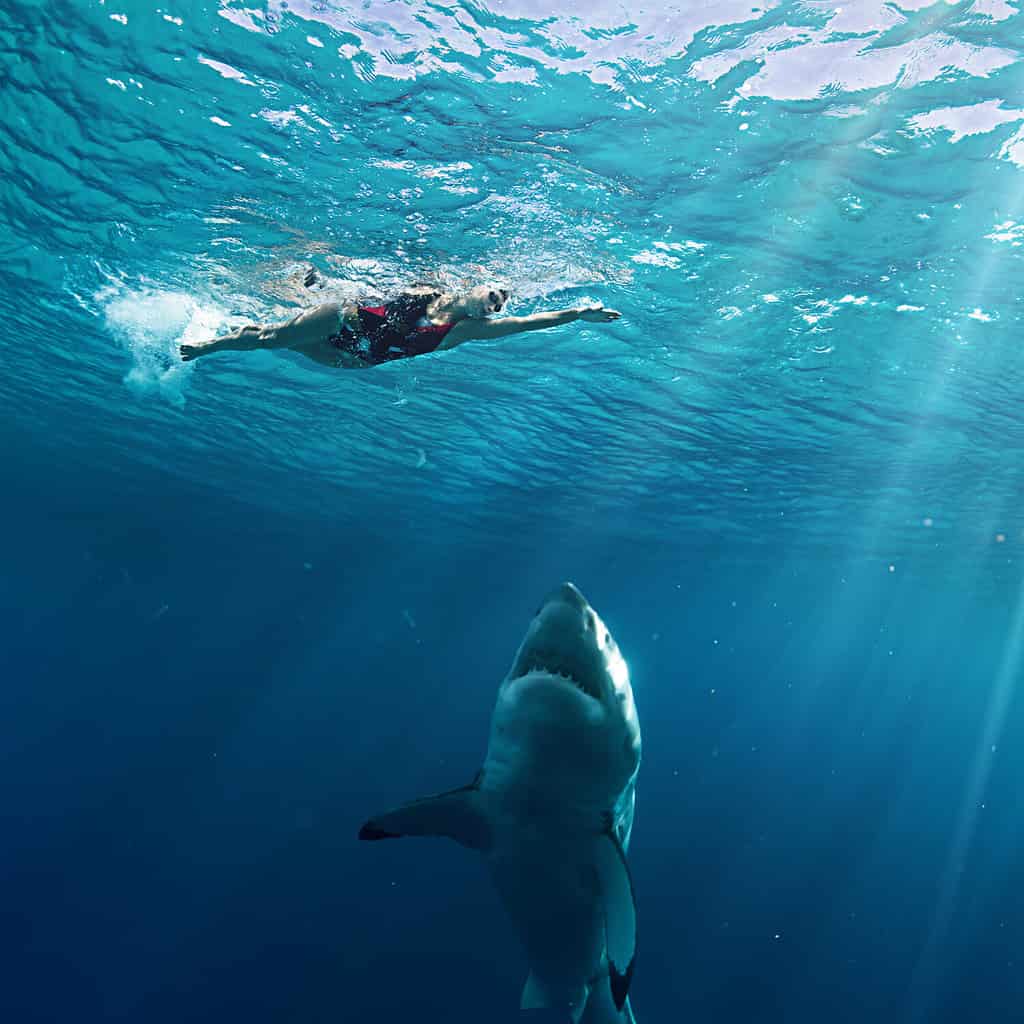
Sharks create instant tension in a movie because of how vulnerable humans are in the water.
©Willyam Bradberry/Shutterstock.com
October is the season of Halloween, and there is no better way to celebrate the spooky season than watching late-night horror movies with friends, family, or significant others. The best horror movies allow the audience to feel the weight of the situation, creating tension. When the scary elements appear, they shock both the characters and the audience.
Through the use of animals, filmmakers create immediate tension and intrigue for the audience. Humans have been living with animals for thousands of years. Pets provide people with unconditional love, and nothing is scarier than seeing a precious pet turn against their owner. Wild animals are even scarier. Many “man against nature” scenarios highlight how an individual human is powerless against most animals.
This article highlights the most popular animals used in horror movies, alongside several movies starring these spooky creatures.
Addressing Horror Movie Animal Stigma
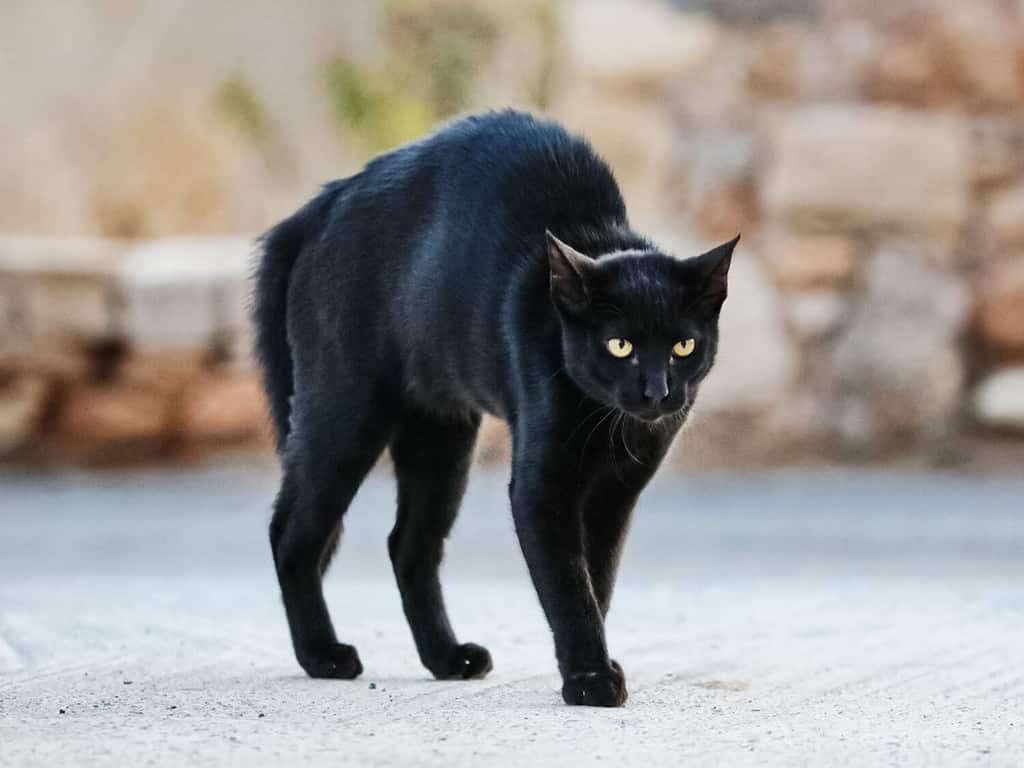
Black cats are less likely to be adopted because of negative bias from media and folklore.
©NZ3/Shutterstock.com
Before starting the list, remember that animals portrayed in horror movies are fictional. The animals may be based on real-life incidents, but they do not depict the whole species. Many animals on this list are unnecessarily persecuted due to fears developed by movies, shows, and other media.
It is imperative to remember that animals are not actively out to kill humans. Animal attacks are due to wild animals struggling to adapt to an environment changed by humans. It is rare for an animal to attack a human with malice, preferring instead to retreat and avoid suffering an injury.
Cats

Jump scares involving cats are common in horror movies to create tension before the real scare.
©Julie Marshall/Shutterstock.com
Cat owners know how treacherous their feline companions can be. Kitties will actively defy their owners and knock objects off the shelf for attention. Horror movies use a cat’s individuality and mystique to make us ask the question, “What if cats were in control?”
For generations, cats have been associated with magic, divinity, and luck (good and bad). Their magical nature is ripe for horror movies. Though they often accompany movie villains, they also sometimes save the main characters from harm.
For example, black cats are seen alongside nefarious witches in the dark and scary woods. The idea of seeing a black cat conjures images of evil, fear, and bad luck. In 1999’s The Mummy, the antagonist of the film is a reanimated corpse who is afraid of cats because they are sacred animals in Egyptian culture. Alternately, the black cat in the family favorite Hocus Pocus protects the children from the life-sucking witches.
Horror movies using cats include:
- Shadow of the Cat (1961)
- Sleepwalkers (1992)
- Cat’s Eye (1985)
- Hocus Pocus (1993)
Dogs
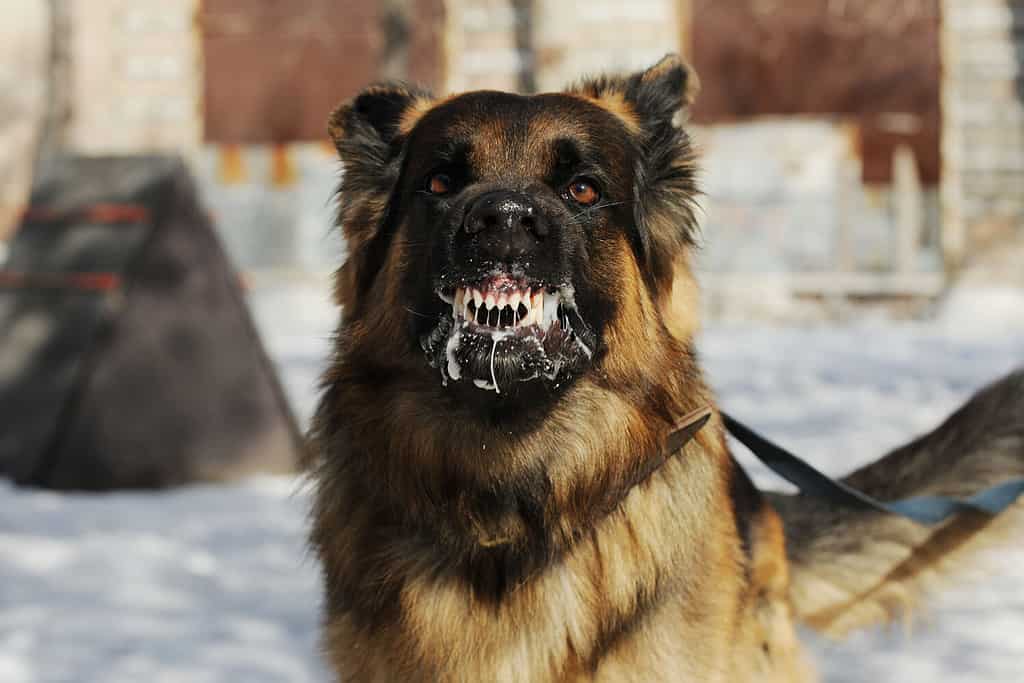
Some dogs can lock their jaws in place to clamp down on prey to break bones.
©Victoria Antonova/Shutterstock.com
Seeing “man’s best friend” turn evil is a frightening experience. A large portion of the population owns dogs and seeing canines turn against their owner or run wild makes audiences uneasy.
Many responsible pet owners have at least some form of control over their dog. Horror movies flip that idea to create a situation where the dog is completely out of control. And the loss of control is always a terrifying and real threat.
Though canine attacks are uncommon, these tragic attacks can and do take place throughout the world. Stray dogs can bite humans while seeking food. Even more threatening, a beloved family pet can attack and kill their owners. The scariest part of canine horror movies is how real the storylines can be.
Alternatively, junkyard dogs are often portrayed in films. These large, intimidating canines are typically pit bulls, rottweilers, or Dobermans. They possess strong bodies, powerful jaws, and intimidating growls that immediately instill fear.
Horror movies with dogs include:
- Cujo (1983)
- Good Boy (2020 + 2022)
- Pet Sematary (1989 + 2019)
- Any movie with a junkyard
Insects
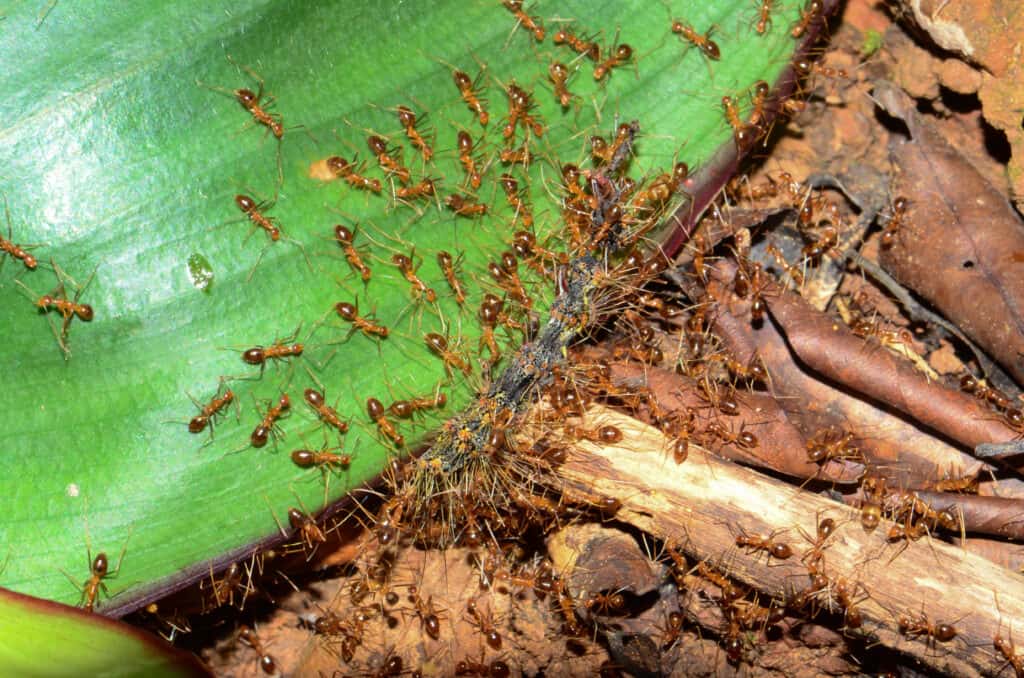
Millions of ants work in tandem to complete goals for the colony.
©demonhero69/Shutterstock.com
Insects are everywhere, skittering and buzzing through every country in the world. Humanity has an innate fear of insects. Horror movies maximize this threat by enlarging the insects to monstrous sizes or depicting enormous, all-consuming swarms.
By increasing insects like ants, locusts, or beetles to kaiju-like size, scary-movie writers dramatically increase the threat they pose to humans. Instead of a small colony of ants, these films depict an ant army capable of overthrowing the country. Likewise, real-life locusts can devastate crops and agriculture, but horror movie swarms can decimate the human population.
Horror movies using insects include:
- Them! (1954)
- The Fly (1958 and 1986)
- The Swarm (1978)
Snakes
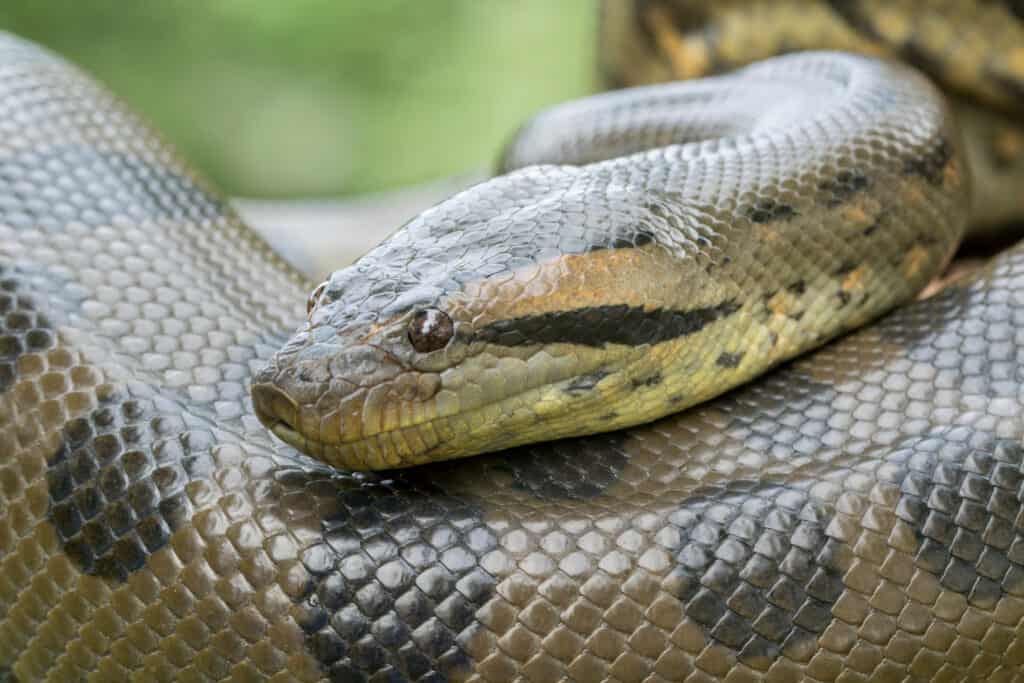
Anacondas are dangerous to pet owners because dogs, cats, and small children are easy prey to squeeze.
©Mark_Kostich/Shutterstock.com
Snakes instill fear in many around the world. Myths from Norway, Europe, and Egypt tell of a monster snake capable of ending the world or eating the sun. South American deities are flying snakes that create the world or devour it. For many, snakes are a terrifying presence linked to primal nature.
Horror movies emphasize the primal fear of snakes through the various sounds they make. Their iconic hissing or rattling immediately sends shivers up the spine. The protagonist may be inches away from suffering a venomous bite or becoming coiled by a massive serpent.
Horror movies like to embellish, increasing the size of a snake to monstrous levels to elevate the threat and heighten tension. In real life, a boa constrictor or anaconda will avoid humans, but a monster anaconda becomes terrifying knowing their appetite cannot be satiated.
Horror movies using snakes include:
- Anaconda (1997)
- Titanoboa (2012)
- Python (2000)
- King Cobra (1999)
Dinosaurs

is a dinosaur action movie that uses horror elements to emphasize the danger.
©Herschel Hoffmeyer/Shutterstock.com
Dinosaurs immediately create intrigue and awe for audiences. Film makers juxtapose the peaceful dinosaurs like triceratops, stegosaurus, or brachiosaurus against the more menacing carnivores.
Ancient apex predators capable of devouring giants are intimidating because humans are powerless against such ferocity. Carnivores like Tyrannosaurus Rex, Allosaurus, and Plesiosaurs are all massive monsters that can easily pick humans apart.
Horror movies using dinosaurs include:
- Beast from 20,000 Fathoms (1953)
- Godzilla (1954)
- 42 (2022)
- The Expedition (2014)
- The Dinosaur Project (2012)
- Jurrassic Park (1993)
Alligators and Crocodiles

Annually, there are more saltwater
crocodile
attacks on humans than shark bites.
©Danny Ye/Shutterstock.com
Alligators and crocodiles are separate animals, but horror movies often lump them together as the same threat. Real-life alligator and crocodile attacks are more common than shark attacks around the world.
Horror movies use the fact that these predators are silent, fast, and deadly in the water to instill fear. These apex predators have not evolved since the age of dinosaurs. Crocodiles and jump scares are a perfect match! Some movies will enlarge the reptiles to increase tension and threat levels.
Horror movies using alligators and crocodiles include:
- Lake Placid (1999)
- Primeval (2007)
- Blackwater Abyss (2020)
- Crawl (2019)
- Rogue (2007)
Wolves (Werewolves)

Some cultures see transforming into an animal as a special ability to commune with nature.
©GSoul/Shutterstock.com
Wolves are distant cousins to domestic dogs, which humans lovingly keep in their homes. Wild wolves are dangerous for their ability to hunt in packs, communicate well, and form societies. They are remarkably similar to humans but still primal.
Horror movies focus on wolves’ similarity to dogs but highlight their ferocity and coordination against isolated humans.
Alternatively, combining wolves and humans into hybrid forms takes on new horror elements. We recognize ourselves in these creatures’ human side, but we are terrified by their uncontrollable transition to maneater. Myths and legends tell numerous stories of humans turning into wolves; the once-human lost in a beastly form.
Horror movies using wolves include:
- Wolfman (1941 and 2010)
- Bad Moon (1996)
- The Grey (2011)
- Werewolf: Beast Among Us (2011)
Spiders
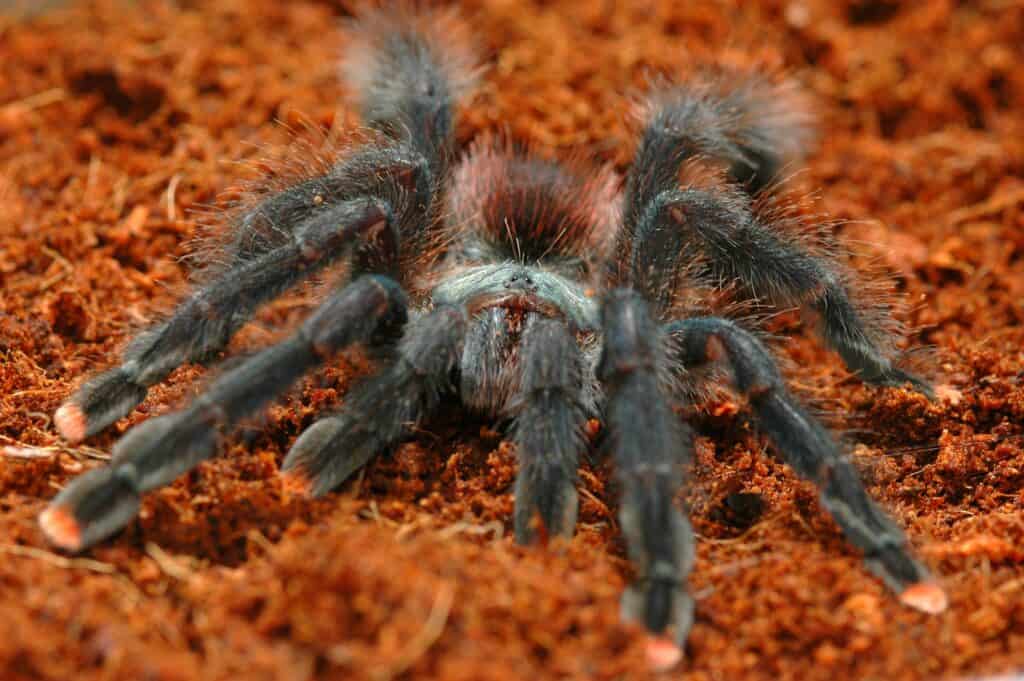
Tarantulas have tiny hairs on their body which irritate predators trying to eat them.
©D. Kucharski K. Kucharska/Shutterstock.com
Similar to insects, humans have an innate fear of spiders. Spiders are strange critters, possessing eight legs and multiple eyes. They create large webs to capture prey, and some have venom toxic enough to kill humans in minutes.
Horror movies take humanity’s primal fear of spiders and elevate it by increasing the spider’s size or creating massive spider infestations for the protagonists to defeat. Emphasizing the spider’s predatory instincts, these arachnids actively chase humans or spin human-sized webs, which ensnare victims.
The scariest part is how spiders consume their prey. Spiders paralyze their prey and inject enzymes to dissolve the body, before drinking their victim.
Horror movies using spiders include:
- Arachnophobia (1990)
- 8-Legged Freaks (2002)
- The Spider (1958)
- The Giant Spider Invasion (1975)
- Tarantula (1955)
- Ice Spiders (2007)
Octopus and Squids

Giant and colossal squid live at such depths that humans rarely encounter them.
©Charles Bévalet. / Public Domain – License
Cephalopods like octopi and squids are sea-dwelling animals that conjure chills. These animals are intelligent, capable of problem-solving, can regenerate their limbs, and reach enormous sizes. For instance, the giant squid is 43 feet long with several hooked tentacles and a massive beak, easily capable of crushing a human. Then, scientists discovered the colossal squid, which can be twice as massive as the giant squid!
Octopuses and squids are absolute incarnations of sea monsters. Ocean-dwelling monsters, like the Kraken, haunted sailors for thousands of years with long arms pulling their ships into the depths. A thinking, problem-solving animal that can regenerate is a physically and mentally formidable foe.
Horror movies using octopi and squid include:
- Kraken (2006)
- The Host (2006)
- It Came from Beneath the Sea (1955)
- Octopus (2000)
- Giant Octopus series
Sharks
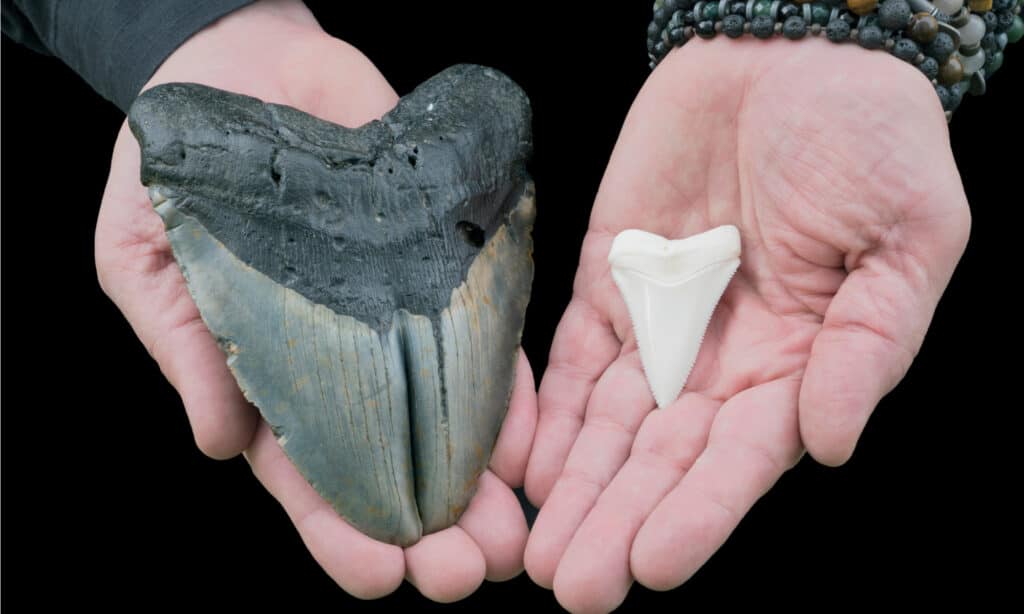
This is a comparison of a
Megalodon
tooth (left) and a great white shark tooth (right).
©Mark_Kostich/Shutterstock.com
Finally, sharks are the most common animals used in horror movies. Because the original 1975 Jaws movie was so popular, it spawned hundreds of shark knock-off movies that tried to recapture that fear. Sharks are terrifying apex predators that are perfectly designed to hunt and kill prey with efficiency. They possess a strong sense to detect prey several miles away, powerful bodies, several rows of jagged teeth, and one of the strongest bite forces in the animal kingdom.
In reality, nearly all shark attacks are accidental. Sharks do not want to eat humans, as we don’t provide enough fat for a decent meal. Humans imitate a struggling fish or seal swimming on the surface, making the shark believe they found recognizable prey. During the attack, the shark quickly realizes its mistake and leaves, but this initial bite can still cause severe damage.
However, there are reported cases of sharks going rogue and actively feeding on humans. These reports strike fear and mass panic in crowds.
Horror movies mostly use great white sharks as the ultimate modern sea predator. More recent movies twist the sharks into man-eating monsters by fusing them with other animals, making them larger than normal, or reviving the extinct Megalodon species to make humans feel powerless against a prehistoric apex predator.
Horror movies using sharks include:
- Jaws (1975)
- The Meg (2018 and 2023)
- Sharknado (2013)
- Sharktopus (2010)
- Deep Blue Sea (1999)
Parting Words
Remember that these movies are works of fiction and the real-life animals they are based on have little or no intention of harming humans. Keep the following in mind:
- Most pit bulls, rottweilers, and Dobermans are non-aggressive and not dangerous.
- Almost no sharks are intentional man-eaters.
- Almost no octopi or squids want to sink ships or crush human bones.
- Snakes do not want to attack people.
- Black cats are not bad luck.
Separating media from reality is crucial to protecting these animals from persecution, harm, and possible extinction.
The photo featured at the top of this post is © iStock.com/PokPak05
Thank you for reading! Have some feedback for us? Contact the AZ Animals editorial team.






